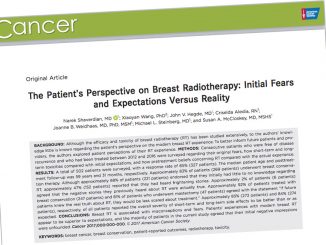Patients play an integral part in the clinical trial process that enables new treatments to be approved and adopted into clinical practice. Without patients, no trials can be undertaken, and thus no drugs can be approved or new standards of care established. Yet, the informed consent process in relation to trial participation indicates that patients are the risk takers in this scenario. The commitment of the trial sponsor to ensure necessary due diligence in deciphering adequate drug dose information with regards to safety and efficacy is often lacking. Is this situation fair?
 What prompted this question was listening to a fascinating discussion on the ethical considerations of phase I oncology trials that unfolded at the October 2017 meeting of the Cancer Research UK Centre for Drug Development. Defining the risk–benefit criteria for participation in a phase I trial is not straightforward. Physicians act in the patient’s best interest to ensure trial participants derive maximum benefit and minimum harm. While therapeutic intent is one aim of first-in-human phase I trials, it is secondary to the overall goal to determine the dose and safety of the drug being tested. To obtain a societal benefit, however, the patient in a trial should not undergo harm. Critics have suggested that trial participants offer too much for a high risk with little benefit.
What prompted this question was listening to a fascinating discussion on the ethical considerations of phase I oncology trials that unfolded at the October 2017 meeting of the Cancer Research UK Centre for Drug Development. Defining the risk–benefit criteria for participation in a phase I trial is not straightforward. Physicians act in the patient’s best interest to ensure trial participants derive maximum benefit and minimum harm. While therapeutic intent is one aim of first-in-human phase I trials, it is secondary to the overall goal to determine the dose and safety of the drug being tested. To obtain a societal benefit, however, the patient in a trial should not undergo harm. Critics have suggested that trial participants offer too much for a high risk with little benefit.
How can we mitigate risk and maximise benefit? What is deemed acceptable risk and adequate gain in a situation when safety cannot be guaranteed? Early clinical safety testing standards have been established to help reduce risk. For instance, the design element and starting dose used in a phase I trial should be considerably below the dose limit likely to cause adverse events. For the first dose being tested, one strategy is to enrol one patient at a time and not on the same day as another patient to limit risk. Although dose-escalation decisions are based on observed toxicity in relation to maintaining efficacy, an inherent tension is created in the steps that are aimed at reducing risk and those that increase the dose to determine the recommended phase II dose (RP2D) in phase I trials.
Patients must understand the pros and cons for them
Therapeutic misconception still exists around informed consent. In one survey, almost 70% of patients assumed they would benefit from a phase I trial. Consequently, what a patient understands in terms of likelihood of personal benefit may ultimately represent an unrealistic patient optimism. Therefore, the possibility of experiencing a life-threatening or severe adverse event in order to address a research question can create an uncomfortable scenario for vulnerable patients. It is important for patients to understand trial objectives and their own risk-versus-benefit gains. However, some clinical trial informed consent forms can be up to a staggering 40 pages and are typically written in technical language that is not easy to understand. In these situations, the nuanced discussion between the patient and physician regarding personal risk–benefit might not materialise when a patient signs an informed consent form. Moreover, the doctor has to shoulder the responsibility of knowing what is relevant for the patient to know and understand in their personal situation when they are entered onto a phase I trial.
It was commented in this meeting that some companies that sponsor trials are insisting on mandatory patient biopsies in order to study how the biology of a tumour changes in response to therapeutic pressure. Whilst this stipulation is understandable and rational in light of the precision medicine era, for those with a primary or metastatic tumour located in a difficult-to-sample location (such as for some lung cancers), such expectations would border on deviating from the Hippocratic Oath of ‘first do no harm’. Most patients entering phase I trials have advanced disease with a poor performance status and poor prognosis, so stipulating multiple biopsies is a big ask. Currently, the onus is on each individual patient to provide signed consent to enrol in early-phase trials. As the benefit to the patient is uncertain in such trials, the added expectation to provide tissue for molecular analysis, potentially involving repeated painful and invasive biopsies, raises considerable concern about the ethical considerations and the purpose served by informed consent.
Towards a fairer framework
Perhaps some degree of reciprocity in the informed consent process would represent a fairer situation. Detailed pharmacokinetic and pharmacodynamic analysis would better determine the minimally effective dose after which further dose escalation adds to toxicity but does not improve efficacy. This is unlikely to be the same for every patient in the phase I trial, which means a dose range should be tested in phase II trials, with the purpose of deciding how to select the right dose for the right patient. Currently, the RP2D that results from a phase I study is typically a single dose that may be associated with a toxicity level that is unacceptable, and might be many times higher than the minimally effective dose. Conversely, it might also be too low a dose for adequate efficacy, especially when subsequent trial testing is performed in an earlier disease setting.
If sponsors had to sign a commitment to perform optimisation work, it may give patients on the trial the best chance of benefit, and maximise the improvements for future patients by ensuring that when new drugs reach the market, we would have a good idea about optimum dosing and cost-effectiveness. It must be possible to achieve a consent process without a cumbersome 40-page consent form. The entire consent form should be brief, consisting of a few pages, which could include a reciprocal component overseen by an independent governing body on behalf of all patients to stipulate safeguards. Furthermore, it could provide a means of promoting an informed and nuanced discussion between doctor and patient about the pros and cons of entering the trial.
“If sponsors had to sign a commitment to perform optimisation work, it may give patients on the trial the best chance of benefit, and maximise the improvements for future patients”
This reciprocity would surely improve our existing drug development and clinical trial process to provide a more transparent, fairer framework for first-in-human and subsequent trials. In later-stage trials that assess an investigational regimen or drug, a reciprocal informed consent arrangement might ensure a greater delivery in value terms. For instance, once an agent is approved it may open a path to negotiate fairer, value-based drug pricing or dosing options, with reimbursement or significant cost-reduction opportunities to healthcare providers or patients post-approval if value is not delivered. In future trials, the responsibility of testing dose variability might enhance adherence, and the translation of research findings in the real world.
Since seamless adaptive clinical trial designs are becoming more popular, a better determination of optimal dose testing in a reciprocity framework might offer a more robust route to help mitigate excessive drug pricing and deliver true value for patients.
Lisa Hutchinson is a Trustee of the Foundation for World Health, London,
and founding Chief Editor Nature Reviews of Clinical Oncology





